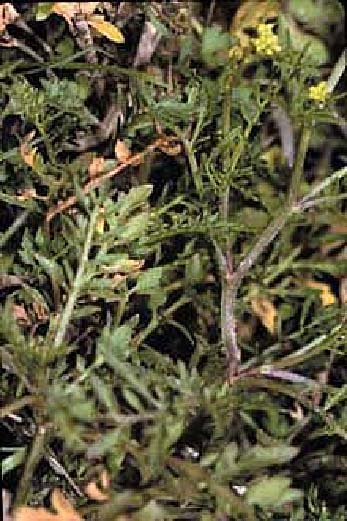Description
Taxonomy
| Kingdom | Phylum | Class | Order | Family | Genus |
|---|---|---|---|---|---|
| Plantae | Magnoliophyta | Magnoliopsida | Capparales | Brassicaceae | Rorippa |
Synonyms
Invasion History
Chesapeake Bay Status
| First Record | Population | Range | Introduction | Residency | Source Region | Native Region | Vectors |
|---|---|---|---|---|---|---|---|
| 1872 | Established | Stable | Introduced | Regular Resident | Europe | Eurasia | Shipping(Dry Ballast) |
History of Spread
Rorippa sylvestris (Creeping Yellow-Cress) is a native wetland plant of Eurasia, first reported from North America in Philadelphia in 1818. Before 1839, it was reported from St. Louis MO, apparently an isolated separate introduction, and by 1859, it was collected near Boston MA. By the 1870s, R. sylvestris was found from Boston to Washington, and by the 1890s, it ranged north to ME, and west to the Great Lakes and upper Mississippi Valley, with isolated occurrences in southern seaports (Stuckey 1966). Numerous reports from dry ballast piles include Mobile AL (Stuckey 1966), Philadelphia PA (Stuckey 1966), and New York NY (Brown 1879). By 1919, it was collected on the West Coast The present range is from Atlantic Canada west to British Columbia, and south to NC, MO (with isolated, apparently old records, from AL, LA, MS) and west to OR. Records are also few and scattered in the Great Plains and Mountain states (Stuckey 1966; Natural Resources Conservation Service 2001).
Reproduction of R. sylvestris is largely vegetative in North America, since seed production is rare. Fragments of roots or stems can be dispersed in dry ballast, with nursery stock, by railroads and highways, or naturally by streams and birds (Stuckey 1966).
In the Chesapeake Bay region, R. sylvestris was first collected in 1872, in Alexandria VA (U.S. National Herbarium collections), and 1873, 'in vicinis Washington D.C.' (Stuckey 1966). Additional specimens were collected in 1876, at Hunting Creek, Alexandria VA in 1879, in Washington DC, in 1897 'wet places above the tideline' in Hunting Creek', in 1898 on 'shores of the Potomac, submerged in pools', and on 'wet ground near Alexandria Light' in 1905 (U.S. National Herbarium collections). Records in VA tidewater counties are confined to the Potomac (Arlington, Farifax, Prince William, and Westmoreland Counties). Other VA records are scattered through the Piedmont and Mountain regions (Natural Resources Conservation Service 2001). In 1880, it was collected in Baltimore County on the Middle River north of the city (Shreve et al. 1910; U.S. National Herbarium collections). In MD, the range is given as 'fields, roadsides and wet areas- the Coastal Plain, infrequent' (Brown and Brown 1984).
References- Brown 1879; Brown and Brown 1984; Natural Resources Conservation Service 2001; Shreve et al. 1910; Stuckey 1966; U.S. National Herbarium collections
Invasion Comments
Ecology
Environmental Tolerances
| For Survival | For Reproduction | |||
|---|---|---|---|---|
| Minimum | Maximum | Minimum | Maximum | |
| Temperature (ºC) | ||||
| Salinity (‰) | 0.0 | 0.0 | ||
| Oxygen | ||||
| pH | ||||
| Salinity Range | fresh-oligo |
Age and Growth
| Male | Female | |
|---|---|---|
| Minimum Adult Size (mm) | 100.0 | 100.0 |
| Typical Adult Size (mm) | 350.0 | 350.0 |
| Maximum Adult Size (mm) | 600.0 | 600.0 |
| Maximum Longevity (yrs) | ||
| Typical Longevity (yrs |
Reproduction
| Start | Peak | End | |
|---|---|---|---|
| Reproductive Season | |||
| Typical Number of Young Per Reproductive Event |
|||
| Sexuality Mode(s) | |||
| Mode(s) of Asexual Reproduction |
|||
| Fertilization Type(s) | |||
| More than One Reproduction Event per Year |
|||
| Reproductive Startegy | |||
| Egg/Seed Form |
Impacts
Economic Impacts in Chesapeake Bay
Rorippa sylvestris (Creeping Yellow-Cress) does not have reported economic impacts in the Chesapeake Bay region.
Economic Impacts Outside of Chesapeake Bay
Rorippa sylvestris (Creeping Yellow-Cress) has been reported as a noxious weed in parts of its US range (Fernald 1950; Natural Resources Conservation Service 2002).
Ecological Impacts on Chesapeake Native Species
Rorippa sylvestris (Creeping Yellow-Cress) has had no reported impacts on native biota in the Chesapeake Bay region.
Ecological Impacts on Other Chesapeake Non-Native Species
Rorippa sylvestris (Creeping Yellow-Cress) has had no reported impacts on native biota in the Chesapeake Bay region.
References
Brown, Addison (1879) Ballast plants in New York City and its vicinity, Bulletin of the Torrey Botanical Club 6: 353-360Brown, Melvin L.; Brown, Russell G. (1984) Herbaceous Plants of Maryland, , College Park. Pp.
Fernald, Merritt L. (1950) Gray's Manual of Botany, In: (Eds.) . , New York. Pp.
Gleason, Henry A. (1963) The new Britton and Brown illustrated flora of the northeastern United States and adjacent Canada, In: (Eds.) . , New York. Pp.
Gleason, Henry A.; Cronquist, Arthur (1991) Manual of vascular plants of northeastern United States and adjacent Canada, In: (Eds.) . , Bronx, New York. Pp.
Harvill, A. M.; Bradley, Ted R.; Stevens, Charles E.; Wieboldt, Thomas F.; Ware, Donna M. E.; Ogle, Douglas W.; Ramsey, Gwynn W.; Fleming, Gary P. (1992) Atlas of the Virginia Flora, , Burkeville, VA. Pp.
Hitchcock, A. S.; Standley, P. C. (1919) Flora of the District of Columbia and Vicinity., In: (Eds.) . , Washington, D. C.. Pp.
1997-2024 USDA PLANTS Database.. Onine databse
Shreve, Forrest M.; Chrysler, M. A.; Blodgett, Frederck H.; Besley, F. W. (1910) The Plant Life of Maryland, , Baltmore. Pp.
Stuckey, Ronald L. (1966) The distribution of Rorippa sylvestris (Cruciferae) in North America., Sida 2: 361-376
Stuckey, Ronald L. (1972) Taxonomy and distribution of the genus Rorippa (Cruciferae) in North America, Sida 4: 279-430
Ward, L. F. (1881) Guide to the flora of Washington and Vicinity, United States National Museum Bulletin 22: 1-264
